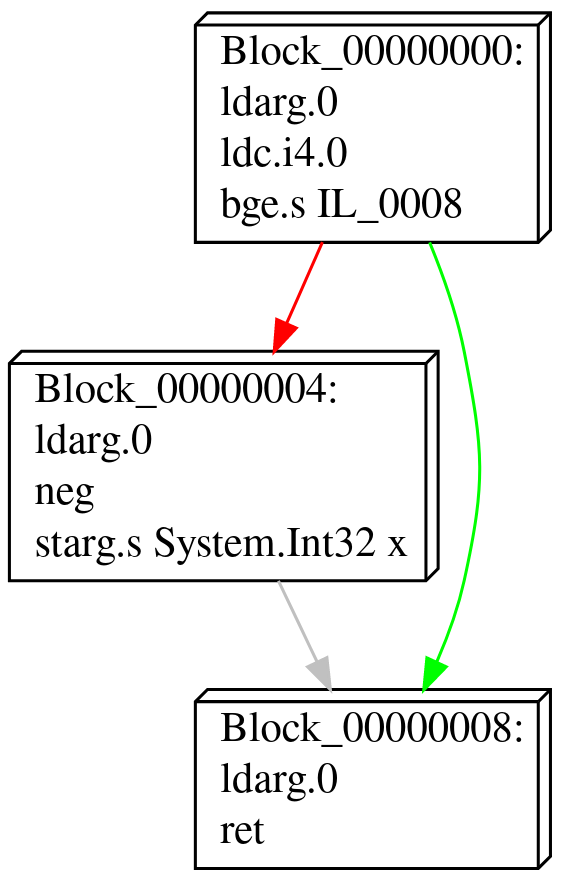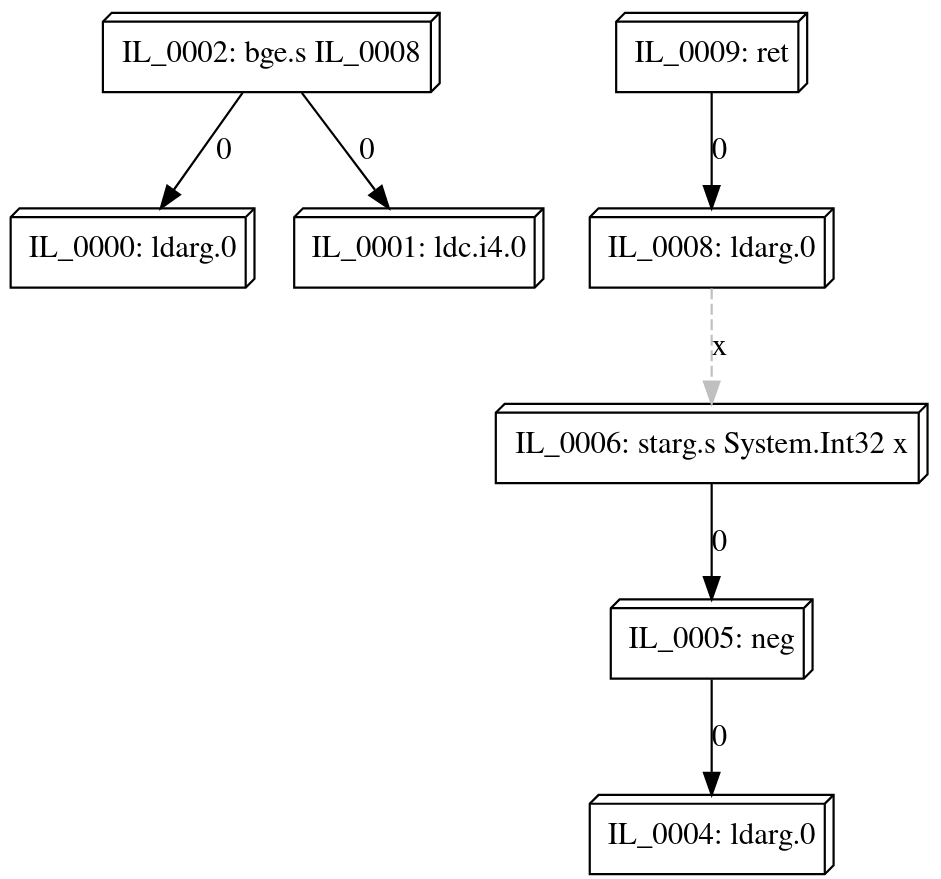Data Flow Graphs (DFG)
Data flow graphs are graphs that encode the dependencies between objects, instructions or components. Where an edge in a control flow graph encodes a possible execution paths a program could take:

an edge in a data flow graph' points to an instruction the node depends on:

Graphs
Every data flow graph is represented using the DataFlowGraph<TInstruction> class.
A new, empty graph can be created by using one of the constructors.
var dfg = new DataFlowGraph<TInstruction>();
To extract a data flow graph from an existing code stream, refer to Symbolic Graph Construction.
Nodes
Nodes in a data flow graph represent the individual components in the code that can introduce dependencies, and are implemented by the DataFlowNode<TInstruction> class.
They can be accessed from the Nodes property:
DataFlowGraph<TInstruction> dfg = ...;
// Iterate over all nodes in a data flow graph:
foreach (var node in dfg.Nodes)
Console.WriteLine(node.Instruction);
Individual nodes can be obtained by looking them up by offset:
var node = dfg.Nodes.GetByOffset(offset: 0x1234);
This performs a linear search through all the nodes, and finds the first node that matches in offset.
To ensure all nodes have updated offsets according to their contents, use the UpdateOffsets method:
dfg.Nodes.UpdateOffsets();
When doing many lookups by offset, consider first creating an offset map for faster lookups.
var offsetMap = dfg.Nodes.CreateOffsetMap();
var n1 = offsetMap[0x0001];
var n2 = offsetMap[0x0004];
var n3 = offsetMap[0x0010];
Edges
Nodes are connected to each other with edges, represented by instances of the DataDependency class.
There are two types of data dependencies Echo distinguishes:
| Type | Description |
|---|---|
StackDependency |
The instruction depends on a value pushed by another instruction on the stack. |
VariableDependency |
The instruction depends on a value set to a variable by another instruction. |
Individual dependenc can be obtained by accessing their respective properties.
For example, the instructions that push values a node depends on can be obtained by querying the StackDependencies property:
DataFlowNode<TInstruction> node = ...;
// Iterate all stack dependencies.
for (int i = 0; i < node.StackDependencies.Count; i++)
{
// Every dependency can have multiple possible data sources.
Console.WriteLine($"Stack value {i}");
foreach (var dataSource in dependency)
Console.WriteLine($"- Value {dataSource.SlotIndex} of {dataSource.Node}.");
}
Similarly, instructions that assign a value to a variable which the node depends on can be obtained by the VariableDependencies property:
DataFlowNode<TInstruction> node = ...;
foreach (var dependency in node.VariableDependencies)
{
Console.WriteLine(dependency.Variable);
foreach (var dataSource in dependency)
Console.WriteLine($" - {dataSource.Node}");
}
Echo defines an extension methods that recursively traverses the DFG and obtains all instructions that an instruction depends on.
DataFlowGraph<TInstruction> node = ...
var dependencies = node.GetOrderedDependencies();
By default, GetOrderedDependencies traverses all edges in the data flow graph.
This includes variable dependencies that were registered in the graph.
If only the stack dependencies are meant to be traversed (e.g. to get the instructions that make up a single expression), additional flags can be specified to alter the behaviour of the traversal.
DataFlowGraph<TInstruction> node = ...
var dependencies = add.GetOrderedDependencies(DependencyCollectionFlags.IncludeStackDependencies);
Warning
When a data dependency has multiple data sources, GetOrderedDependencies will only choose one.
The method is defined to find one sequence of instructions that produce the values of the dependencies, not all possible sequences of instructions.
It is undefined which sequence is picked.
Visualizations
Echo provides default serializers for graphs in DOT format.
using var writer = File.CreateText("output.dot");
cfg.ToDotGraph(writer);
These can then be visualized using e.g., GraphViz.